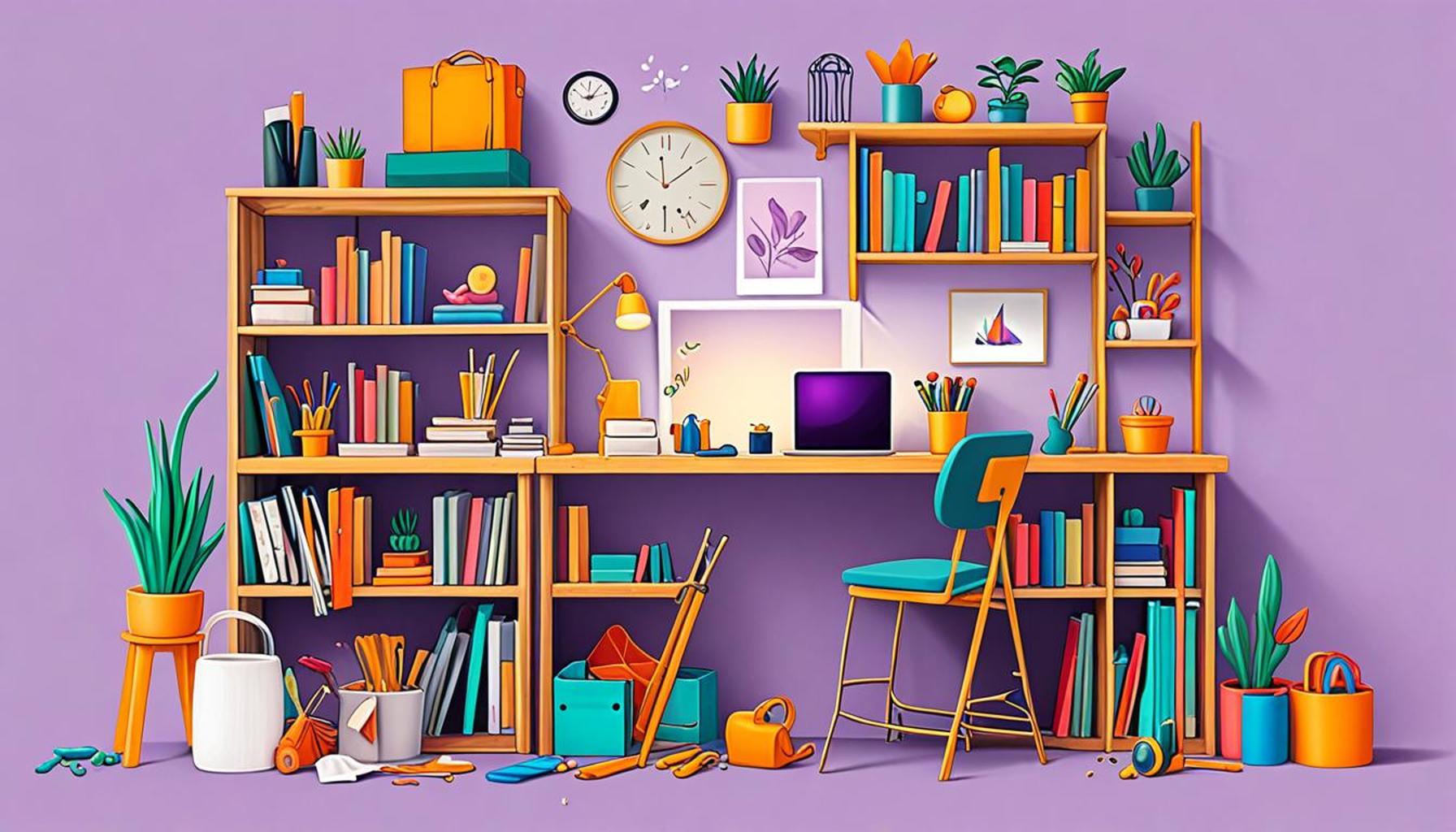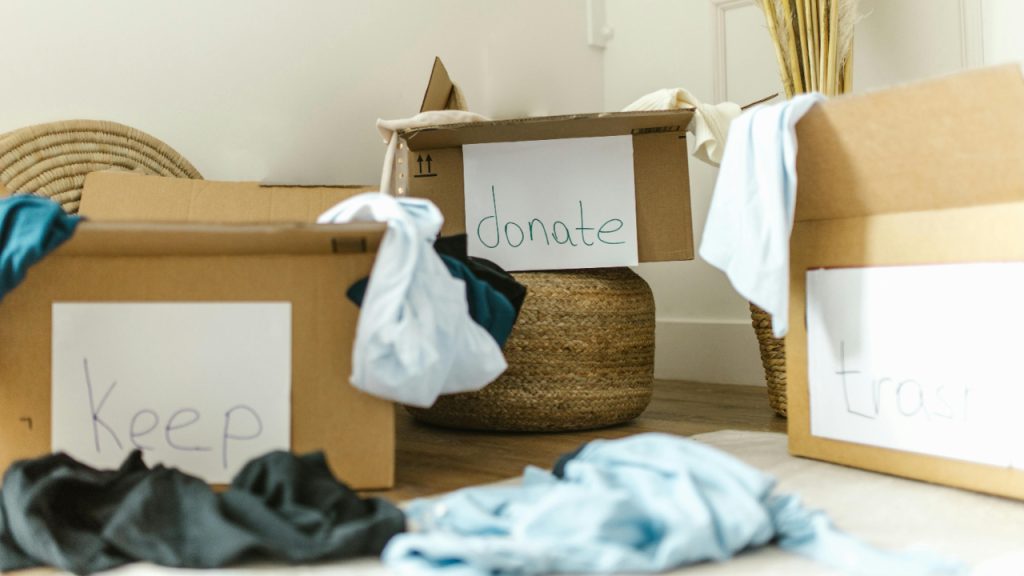Mindful Decluttering: Techniques to Cultivate Presence While Organizing Your Space

The Transformative Power of Mindful Decluttering
In a world bustling with distractions, mindful decluttering emerges as a transformative practice that not only tidies up our spaces but also offers clarity to our minds. Many people grapple with consumerism and clutter in their daily lives, leading to an overwhelming sense of chaos. By embracing the technique of mindful decluttering, individuals can foster a deeper sense of presence, allowing for both physical and mental organization. This practice, far from being a mere chore, can evolve into a rewarding journey of self-discovery and emotional improvement.
Embracing Awareness
One of the core aspects of mindful decluttering is awareness. Engaging fully in the process means actively reflecting on one’s relationship with belongings. For instance, while sorting through clothing items, ask yourself important questions: Do I truly wear this? Does it resonate with my current self? This reflection can unveil insights about personal growth and changes in interests or values over time. Keeping a journal during this process can help track these discoveries and provide a future reference point.
The Importance of Selectivity
Selectivity is another fundamental principle. Choosing items that genuinely spark joy or serve a purpose encourages a renewed appreciation for what one has. In a culture often characterized by excess, this turns the act of decluttering into a celebration of meaningful possessions. For example, someone might decide to keep a handmade gift from a loved one while parting with items bought out of obligation or trends that now seem unimportant. This selective approach opens up space both physically and emotionally, allowing individuals to cherish their surroundings and their connections.
Intentional Living Spaces
Moreover, practicing intentionality in every aspect of life can culminate in creating a more harmonious living space. An environment cluttered with unnecessary items can inhibit productivity and peace of mind. By ensuring that each item serves a purpose, whether it is functional or sentimental, individuals cultivate a sanctuary that nurtures their well-being. Simple adjustments, such as a designated space for each item or organizing based on usage frequency, can lead to significant enhancements in daily routines.
When active participation in decluttering is embraced, a sense of moment-to-moment awareness unfolds—this awareness extends beyond the act of organizing and can positively affect emotional well-being. For many across the United States, the correlation between a clear home and a clearer mind is palpable. Studies have shown that environments with less clutter can decrease stress levels and increase focus, tapping into the very essence of mindful living.

Techniques and Resources
Exploring the myriad techniques available for mindful decluttering can enrich this experience. Methods range from minimalism, which emphasizes the importance of living with less, to more meditative practices that encourage deep reflection while decluttering. Books such as “The Life-Changing Magic of Tidying Up” by Marie Kondo have inspired countless individuals to rethink their spaces. Online forums and community workshops are also great resources for finding support and shared experiences in this transformative journey.
Ultimately, the journey into mindful decluttering transcends mere tidying; it is about transforming your environment and enhancing your presence in the world. By adopting these principles and exploring the rich array of techniques available, you can not only create a physically organized space but also cultivate a profound clarity that resonates deeply within.
DISCOVER MORE: Click here for tips on dividing small spaces
Crafting a Decluttering Mindset
To embark on the journey of mindful decluttering, it’s essential to first cultivate the right mindset. This involves shifting from viewing decluttering as a mundane task to embracing it as an opportunity for personal growth and clarity. A fundamental step is to practice gratitude for the items we choose to let go. Acknowledging the role that these belongings played in our lives can help us release them with a sense of purpose rather than guilt. This mental shift not only eases the emotional weight of parting with possessions but also reinforces our commitment to maintaining only what serves us well.
Creating a Decluttering Ritual
Incorporating ritualistic elements into the decluttering process can significantly enhance one’s experience. Establishing a specific time and environment dedicated to mindful decluttering allows for focus and intentionality. Here are some steps to create an effective decluttering ritual:
- Choose a Comfortable Space: Select a serene area in your home where you can feel at ease and concentrate fully.
- Gather Supplies: Equip yourself with bins or boxes labeled “Keep,” “Donate,” and <strong“Trash.” This visual categorization helps streamline decisions.
- Set a Timer: Allocate a specific time frame, such as 30 minutes or one hour, to avoid overwhelm and maintain focus.
- Play Mindful Music: Create a playlist that promotes relaxation. Music can elevate the mood and create a calming atmosphere.
During this ritual, engage your senses. Feel the fabric of clothing as you decide its fate, inhale the fresh air while sorting through books, or notice the textures of decorative items. This sensory engagement fosters a deeper connection to the process, helping to reinforce presence.
Mindfulness Techniques for Clarity
In addition to creating a ritual, integrating mindfulness techniques while organizing can enhance the overall experience. A few strategies include:
- Deep Breathing: Before starting, take a few deep breaths to center yourself. This practice helps ground your mind and prepares you for focus.
- Visualization: Envision your ideal living space before you start. Keeping this image in mind can motivate change and remind you of your goals during the process.
- One Item at a Time: Limit your focus to one item or category before moving on. This concentration reduces feelings of being overwhelmed and enhances decision-making.
By incorporating these mindfulness techniques, decluttering evolves into a practice that nurtures both your physical environment and your mental state. As you progress, celebrate small wins—each item you part with opens up space for the new and meaningful. This gradual approach reinforces an ongoing relationship with your belongings, fostering a sense of presence that lasts well beyond the decluttering event itself.
| Technique | Description |
|---|---|
| The 5-Item Rule | Choose five items to declutter daily, encouraging a steady, manageable pace. |
| Mindful Sorting | Engage fully in the decision-making process for each item, fostering awareness and intention. |
| Gratitude Practice | Reflect on the role each item played in your life before letting it go. |
Exploring Each Technique
Incorporating these techniques not only enhances your space but also nurtures mindfulness. For instance, the 5-Item Rule allows decluttering to fit seamlessly into busy schedules, while promoting a sense of accomplishment. As you progressively let go of unnecessary items, it instills a feeling of lightness and clarity within your living environment. Mindful sorting pushes you to connect with your belongings, identifying what truly adds value to your life. This practice not only declutters your physical space but also clears mental clutter. Finally, introducing a gratitude practice transforms the act of discarding into a respectful farewell, enhancing emotional well-being and teaching you to appreciate the transience of material possessions. Together, these methods create a holistic approach to organizing that cultivates presence and enhances awareness. Engaging in this process can lead to a significant shift in how you interact with your environment.
DISCOVER MORE: Click here to simplify your daily life
Connecting Emotionally with Your Belongings
Understanding the emotional ties we have to our possessions is crucial in the mindful decluttering process. Each item in our space tells a story; it may evoke memories from significant life events or represent past experiences. To navigate these emotional connections thoughtfully, consider employing the following strategies:
- The Memory Method: As you sort through items, take a moment to remember the occasion that brought each item into your life. This practice not only honors the memory but also helps assess its relevance to your current self.
- Ask Critical Questions: Pose questions to yourself as you handle each item: Does it spark joy? Does it contribute to my present life? Is it a reminder of who I once was, rather than who I am today? These reflections can significantly influence your decisions.
- Emotional Inventory: Keep a small notebook handy to jot down your feelings or thoughts about certain items as you declutter. This written record can help clarify why you are keeping some items while letting go of others.
By forging a deeper connection with your belongings, you create a more meaningful decluttering experience that fosters not just physical but also emotional clarity. This intentional assessment encourages you to prioritize what truly aligns with your values and purpose.
The Role of Minimalism in Mindful Decluttering
While decluttering serves as a pathway to personal tranquility, integrating the principles of minimalism can enhance the journey. Minimalism advocates for living with less to embrace life more fully, aligning perfectly with the essence of mindful decluttering. Practical applications of minimalism can include:
- Adopting a “One In, One Out” Rule: For every new item that comes into your space, commit to removing another. This simple rule provides a clear guideline to prevent clutter from accumulating again.
- Creating a Capsule Wardrobe: Streamlining your wardrobe to a collection of versatile pieces not only reduces clutter but also simplifies daily decision-making. This minimalist strategy emphasizes quality over quantity.
- Simplifying Surfaces: Aim for clear surfaces in each room, such as tables and countertops. A bare surface serves as a visual reminder of space and peace, minimizing distractions in your environment.
Implementing these minimalist principles can coalesce beautifully with your mindful decluttering efforts, ultimately aiding in creating a serene, organized space that inspires presence and mindfulness every day.
Embracing the Journey
Mindful decluttering is not merely about achieving a desirable aesthetic; it’s a transformative practice that promotes overall well-being. As you embark on this journey, maintain a sense of curiosity and openness. Acknowledge that, while the immediate task may seem daunting, each moment spent organizing your space is an opportunity for reflection and self-discovery. Consider the journey as a way to declutter your mind as much as your environment—like peeling back layers to uncover what truly matters.
Moreover, inspiration can often strike from various sources; think of resources like books on minimalism or documentaries that illustrate the value of a clutter-free life. Engaging with these materials can reinforce your commitment to embracing a simplified lifestyle while enhancing your understanding of mindful decluttering techniques.
DISCOVER MORE: Click here to uncover emotional techniques for decluttering
Finding Balance Through Mindful Decluttering
In today’s fast-paced world, mindful decluttering emerges as a powerful tool to not only organize our spaces but also to enhance our well-being. The practices discussed highlight the significance of connecting emotionally with our belongings, allowing us to honor our past while making room for the present. By embracing techniques such as the Memory Method and asking critical questions, we embrace a thoughtful evaluation of what we truly need in our lives.
Furthermore, the integration of minimalism into our decluttering process can elevate our experience. Implementing simple rules like “One In, One Out” or creating a capsule wardrobe can lead to clarity and peace within our environments. These principles encourage us to prioritize quality over quantity, ultimately supporting a more mindful lifestyle.
As you embark on your decluttering journey, remember that it’s more than just clearing space; it’s a process of self-discovery and introspection. Approach it with curiosity and openness, recognizing each moment spent organizing as an opportunity to reflect on what truly matters in your life. Consider utilizing additional inspiration from books or documentaries that champion the benefits of a clutter-free existence. Engaging with these resources can deepen your understanding and commitment to the practice of mindful decluttering.
In conclusion, mindful decluttering is an ongoing journey rather than a singular goal. By cultivating presence through intentional organization, we not only transform our physical spaces but also foster emotional wellness and clarity in our lives. Your quest for a harmonious environment can lead to greater fulfillment, enriching your journey towards a simpler, more meaningful existence.


